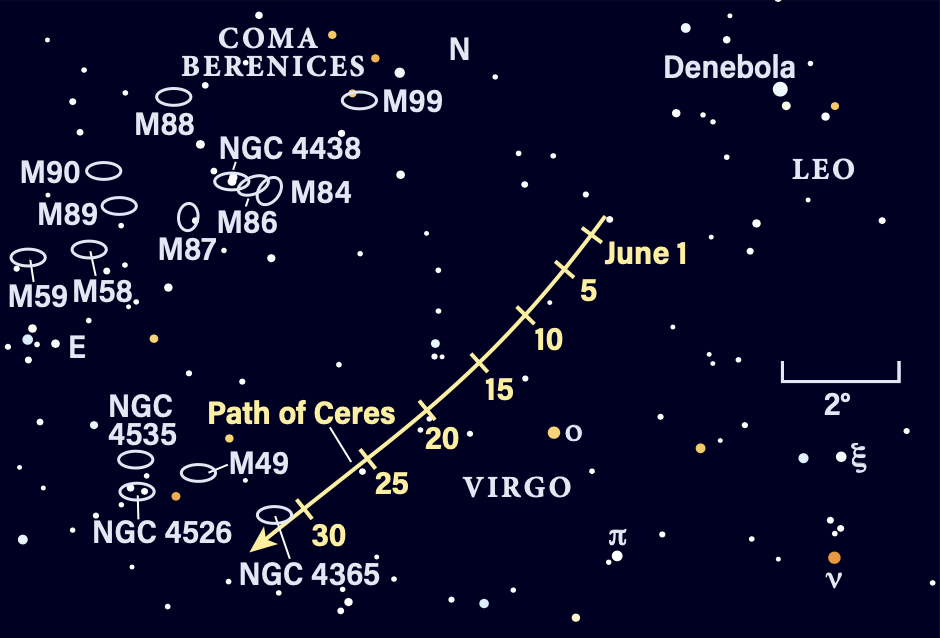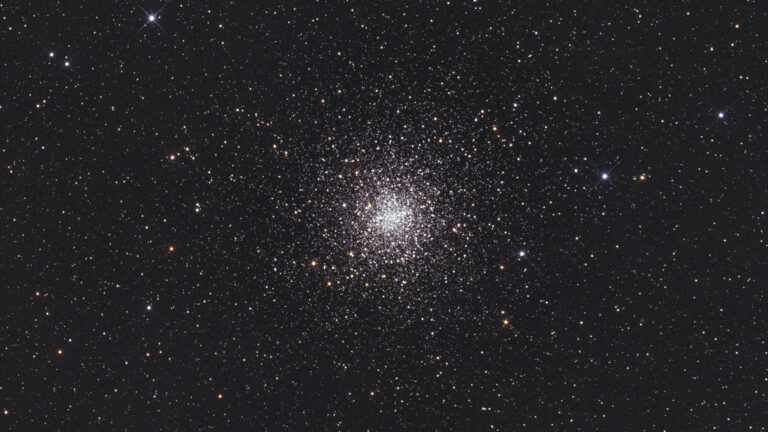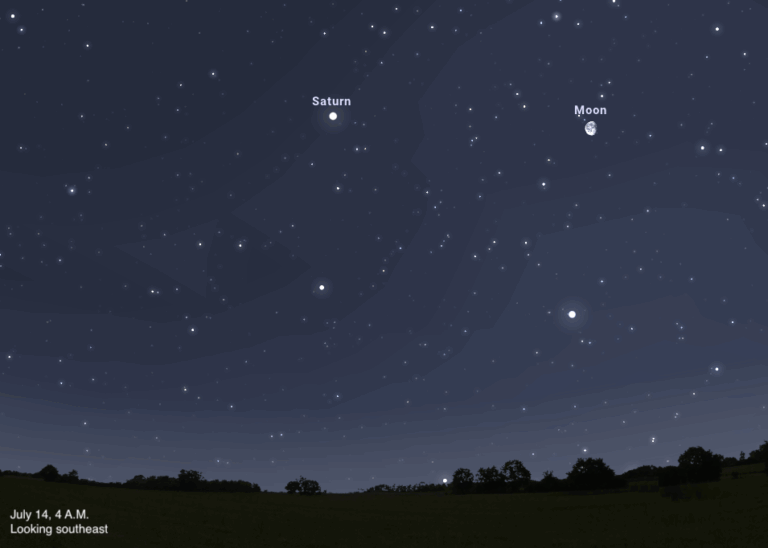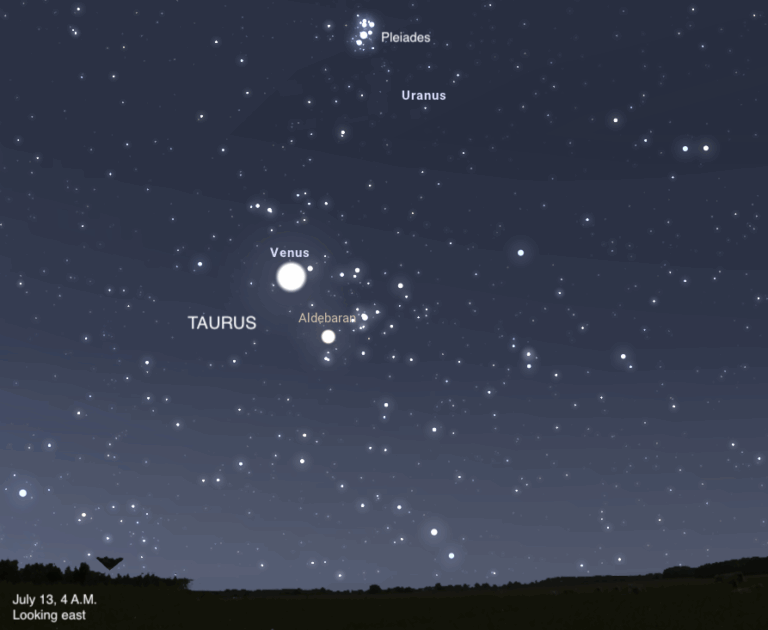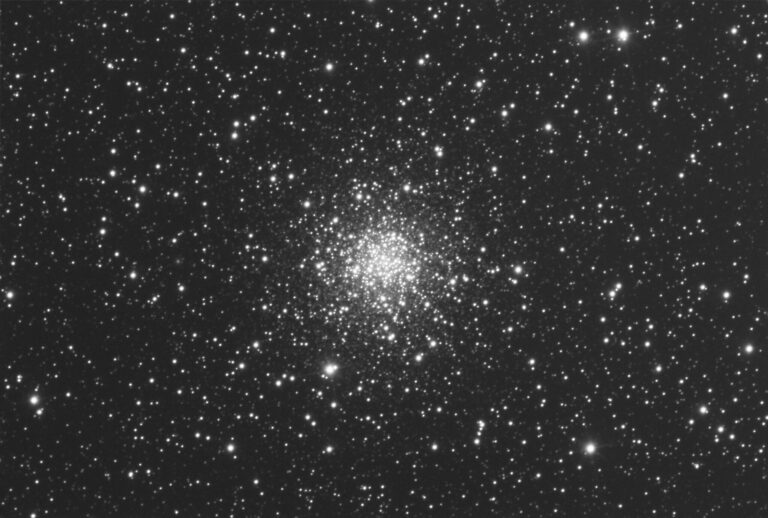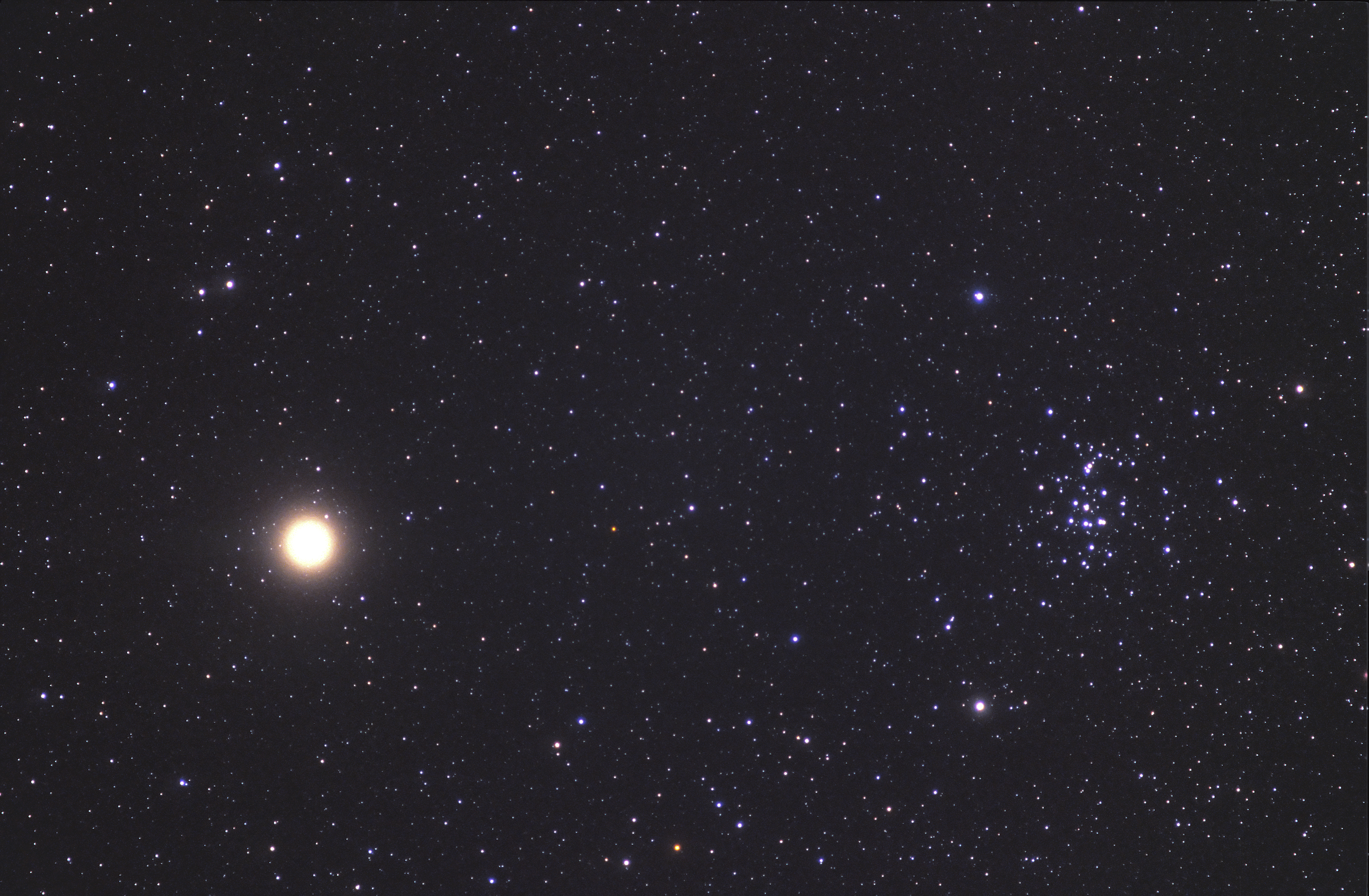
Key Takeaways:
Venus reaches its best for the year as an evening object this month. Its brilliance captures attention long after sunset. Meanwhile, Mars continues to fade but enjoys a beautiful meeting with the Beehive Cluster, a view not to be missed. Saturn and Jupiter appear after midnight and offer some fine views, while the predawn sky hosts Mercury, best seen in the first half of June.
Soon after sunset you’ll find Venus high in the evening sky, reaching its greatest eastern elongation June 4. At 45° from the Sun, the planet remains a spectacular evening star for more than three hours after sunset. It stays highly visible all month, unmissable as it starts out at magnitude –4.4 and brightens to magnitude –4.7 by the end of June.
On June 1, Venus is in Gemini, 30° above the western horizon 30 minutes after sunset. The planet lines up with Castor and Pollux, the constellation’s twin 1st-magnitude stars. It crosses into Cancer June 3 and stands 10° from Mars, which is located nicely next to the Beehive Cluster (M44; more on that shortly).
A telescopic view reveals Venus is 50 percent lit, although the timing of this so-called dichotomy is affected by a variety of circumstances. Called Schröter’s effect, Venus can appear exactly half lit a few days before eastern elongation. Astronomers believe this effect is due to a combination of light scattering at twilight combined with the shading near the terminator of Venus. Watch the planet for the few days before and after greatest elongation and make your best judgment.

Entering the second week of June, Venus approaches the Beehive Cluster, arriving within 1.1° of these stars on June 12 and standing 0.8° north of M44 on the 13th.
Whenever a crescent Moon joins Venus, the view in evening twilight is stunning. You’ll see this pairing on June 21, when the two are 3° apart. Mars, in Leo, stands 4.5° from Venus, while M44 lies 7° west of Venus.
Venus continues to chase the Red Planet, narrowing the gap between them to less than 4° by June 30 but never quite catching up, so there’s no real conjunction. Regulus, Leo’s brightest star, is less than 6° from Mars on this last day of the month. The telescopic view of Venus has changed radically, now showing a 32-percent-lit crescent spanning 34″. Venus sets shortly before 11 P.M. local daylight time on June 30.
Mars dims 0.1 magnitude to 1.7 during June as it precedes Venus across Cancer and moves into Leo just after midmonth. Don’t miss the Red Planet nestled among the stars of M44 on June 1 and 2. The binocular view is beautiful; the telescopic view is stunning. Mars is a brilliant magnitude 1.6 ruby embedded in a sea of fainter diamonds. Catch it early, soon after 9 P.M. local time. By the end of June, Mars is setting an hour before midnight.
Mars displays a tiny 5″-wide disk in telescopes. It continues its slow progression toward a November solar conjunction and remains in the evening sky for a few more months.
Saturn rises at 1:30 A.M. local time on June 1 and is well above the horizon in the east by midnight on June 30. It’s two months from opposition and a fine target for any telescope. Located in the middle of Aquarius, Saturn rises to about 40° elevation by sunrise from mid-latitudes in the U.S. It’s the brightest object between the Square of Pegasus and the 1st-magnitude star Fomalhaut, which rises a little more than 90 minutes after Saturn.
The ringed planet shines at magnitude 0.8 early in the month. Through a telescope, its yellowish disk is 17″ across. The rings’ tilt reaches a minimum for the year this month at 7.3°. Their long axis subtends 40″, while the narrow axis is just shy of 5″.
Saturn’s brightest moon, Titan, shines at magnitude 8.6. It is due north of the planet June 5 and 21, and due south June 13 and 29. Other, fainter moons are closer to the planet, shining from 9th to 11th magnitude.
Iapetus reaches western elongation June 24, when it shines brighter than average. This is because at this point in Iapetus’ nearly 80-day orbit, its brighter hemisphere is facing Earth. Prior to elongation, Iapetus passes 34″ north of Saturn on the morning of June 3. On the following morning, it stands 18″ east of bright Titan before dawn, enabling easy identification of the fainter (magnitude 11) Iapetus. You can then follow it westward as it increases its separation from Saturn, reaching 9′ by the 24th.
Neptune stands 20° above the eastern horizon around 4:30 A.M. local time as June opens. It lies about 20° east of Saturn, just across the border from Aquarius in southwestern Pisces. If you can easily spot the Circlet of Pisces due south of the Square of Pegasus, then you can find Neptune 4.5° southeast of 4th-magnitude Lambda (λ) Piscium.
You’ll need binoculars to spot this remote planet. Shining at magnitude 7.8, it forms a neat triangle with 5th-magnitude 20 Piscium and 6th-magnitude 24 Piscium. These two stars are part of a trio that lie in a straight line spanning about 3°. The brightest is 5th-magnitude 27 Piscium at the eastern end of the line.
By June 25, Neptune’s easterly motion slows almost to a halt and the planet stands about 1° north of 24 Piscium for about three weeks with little sign of motion relative to the background stars.
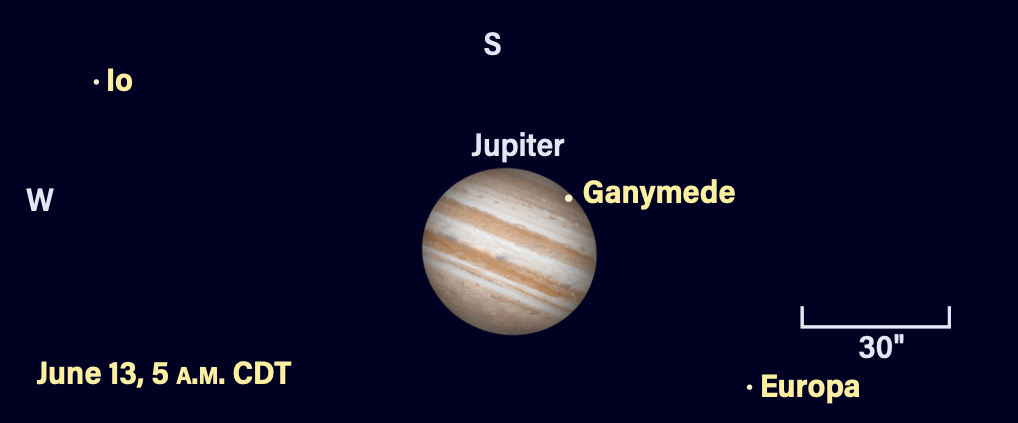
Jupiter has arrived in Aries the Ram. The giant planet rises just before 4:00 A.M. local time on June 1 and about two hours earlier on June 30. Its brightness increases slightly from magnitude –2.1 to –2.2, making it easy to spot over the eastern horizon before dawn. Catch the waning crescent Moon sitting less than 3° east of Jupiter on the morning of June 14.
Observing Jupiter is a challenge in early June due to its low altitude at the onset of twilight. Things steadily improve as the month progresses. On June 30, Jupiter stands 30° high in the east as twilight begins. This offers a short period to observe the planet as it climbs above the haze and turbulence of our own atmosphere. Check the state of its dark belts and bright zones.
The Galilean satellites — Io, Europa, Ganymede, and Callisto — orbit Jupiter in its equatorial plane. The current tilt relative to Earth causes Callisto to miss passing in front of the planet. The remaining three moons transit or are occulted by Jupiter’s disk from time to time. The observing window is narrow, but there are a few interesting events this month.
On June 11, several observable events occur. As Jupiter rises on the East Coast, there’s a shadow on the disk; it belongs to Io, approaching the eastern limb. By the time Jupiter clears the horizon in the Midwest, Io is transiting between two shadows: its own to the west and Europa’s to the east. Meanwhile, Europa itself is east of the disk. Io’s transit ends just before 4:40 A.M. CDT. Within 10 minutes, Europa begins a transit. Note the relative position of Europa and its shadow and you get a sense of the direction the Sun is shining relative to our view. Europa’s shadow leaves around 5:10 A.M. CDT, as twilight floods the Midwest. Pacific Coast observers will see much of Europa’s transit.
The giant moon Ganymede transits Jupiter’s southern polar region June 13 between 4:47 A.M. and 6:44 A.M. CDT. Its path is indicative of the tilt of the moons’ orbital plane. The transit technically starts several minutes earlier; the slow-moving moon takes more than 10 minutes to fully move onto the disk of Jupiter.
The tilt of the orbital plane is emphasized again the morning of June 17, when Callisto stands due south of Jupiter.
Io and its shadow transit early on June 18. The eastern half of the country will see the shadow transit starting around 4:25 A.M. EDT, followed by the moon itself just over an hour later at 5:28 A.M. EDT. The western U.S. will see Europa’s shadow begin a transit at 3:26 A.M. PDT. Some of these events are affected by twilight, depending on your geographic location.
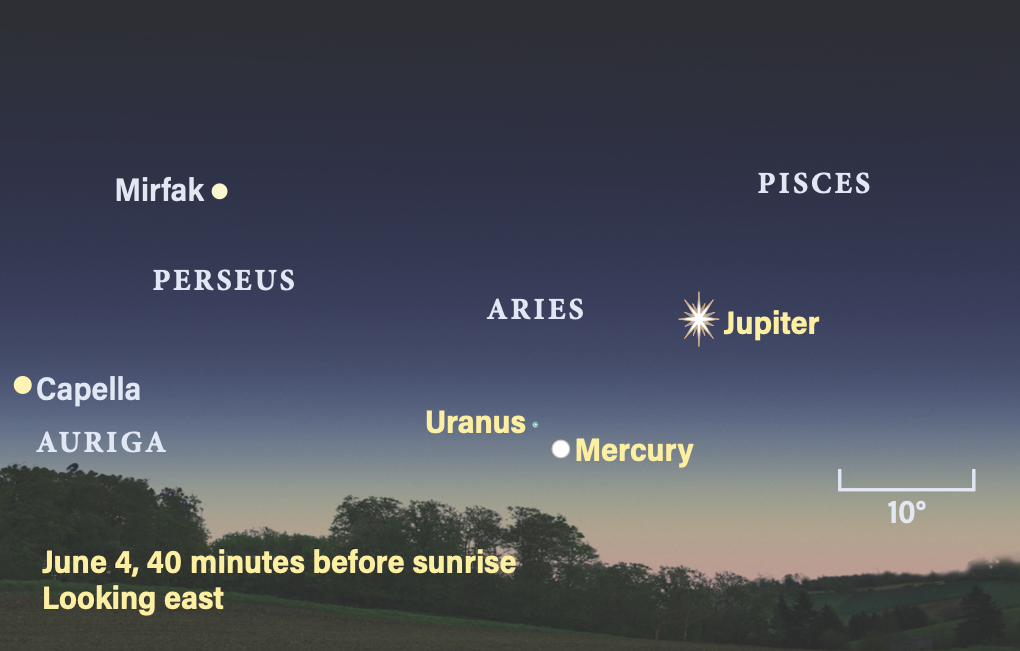
There’s a narrow window to spot Uranus before twilight encroaches. The planet lies about 16° east of Jupiter. It, too, is in Aries, just 10° southwest of the Pleiades (M45) in Taurus. Uranus shines at magnitude 5.9 and requires binoculars to spot.
The ice giant is 1.6° southwest of the waning crescent Moon on June 15 — but catch it shortly after moonrise, say around 3:50 A.M. local time, before the oncoming twilight.
Uranus lies about 2° from 4th-magnitude Delta (δ) Arietis. Catch the planet wandering south of Delta in late June before twilight hides them.
On June 1, Mercury is just three days past greatest elongation. It rises less than an hour after Jupiter and is 13° east of the giant planet. As its elongation from the Sun decreases, Mercury brightens from magnitude 0.4 on the 1st to magnitude –1.0 on June 19.
On June 4, can you catch Uranus 3° due north of Mercury? It’s a challenging observation, aided by viewing with binoculars from higher elevations. The fast-approaching twilight will quickly hide the more distant planet. Mercury stands 4° above the horizon 40 minutes before sunrise.
Mercury reaches magnitude –0.2 on June 10, when it is 7° south of M45, whose stars are faintly visible in twilight. On June 16, a waning crescent Moon hangs less than 5° above Mercury’s location; the magnitude –0.7 planet is now so low that it is challenging to spot. As the sky brightens, try to see Aldebaran 4.5° southeast of Mercury. Equatorial and Southern Hemisphere observers will have a better chance.
Mercury quickly disappears from view even as it brightens, growing too close to the Sun for observation late in the month. It reaches superior conjunction as July begins.
The summer solstice occurs June 21 at 11 A.M. EDT. This marks the date when the Sun is at its northernmost declination.
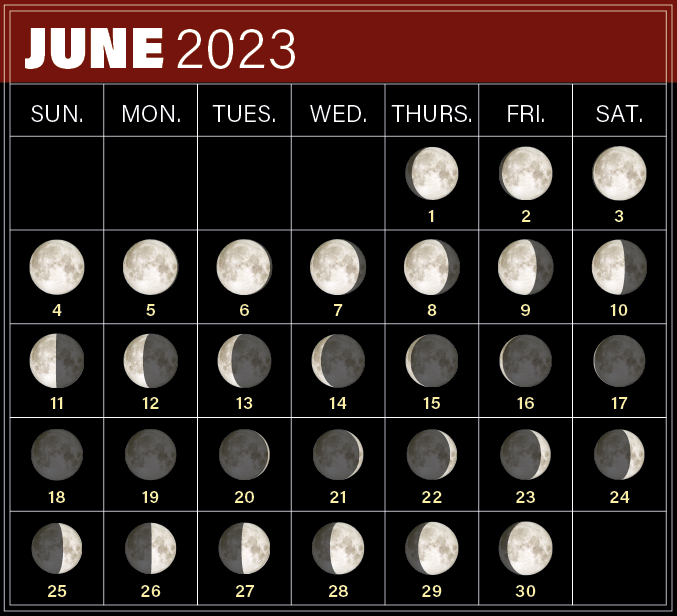
Rising Moon: Almost extremes
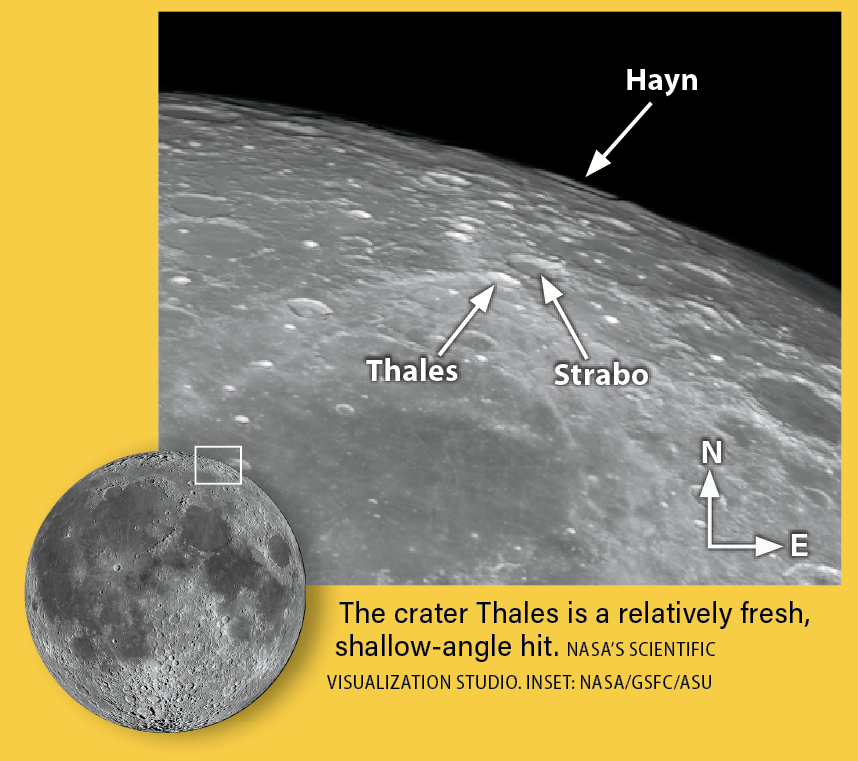
Our media does not celebrate second-place finishes very well, but this month’s Full Moon on the 3rd has plenty of them. The Moon is just over two days from perigee, its closest approach to Earth, puffing out to a mere 1.2′ less than the 33.7′ of August’s coming maximum. Luna remains yellow tonight thanks to its significantly negative declination, tracing the lowest arc the Full Moon can take — this year. It will be slightly outdone in 2024.
Take in the fantastic rays from Tycho at low power (use a blue filter to cut down on the glare), then boost the magnification and check out the far northeast limb. Where one ray passes east of the long Mare Frigoris, there’s a countering V shape of rays spreading back. The point of the V is the crater Thales, named for the Greek mathematician. Not only is this a classic “fresh” impact crater (still a few hundred million years old), it is a shallow-angle hit that makes butterfly rays like Proclus on the west side of Mare Crisium. The shallowness of the angle isn’t as extreme as Messier farther south, though.
Pass through Strabo and onto the limb to pick out Hayn, just about in profile. The low and flat Mare Humboltianum reveals its depth on the 4th as it lies in shadow, giving the limb quite a divot. Speaking of shadows, the ones close to the north pole are putting on a striking 3D show (as showcased in the July 2021 issue). The view practically repeats July 2nd.
Meteor Watch: Midnight glow
There are no major meteors showers in June, but look out for those beautiful sporadic summer meteors that can coast across the Milky Way (or anywhere in the sky) at random moments.
Midsummer is also the time of year when more northerly locations get to experience noctilucent clouds. North of 55° latitude in Canada and northern Europe are good places to view these iridescent clouds, which sit some 10 times higher than cirrus and glow long after lower-level clouds appear dark. Noctilucent clouds are produced when ice crystals form on tiny dust particles; sunlight can illuminate them even at local midnight. In recent years, time-lapse photography has produced beautiful evidence of the ebb and flow of these elusive visitors of the night.
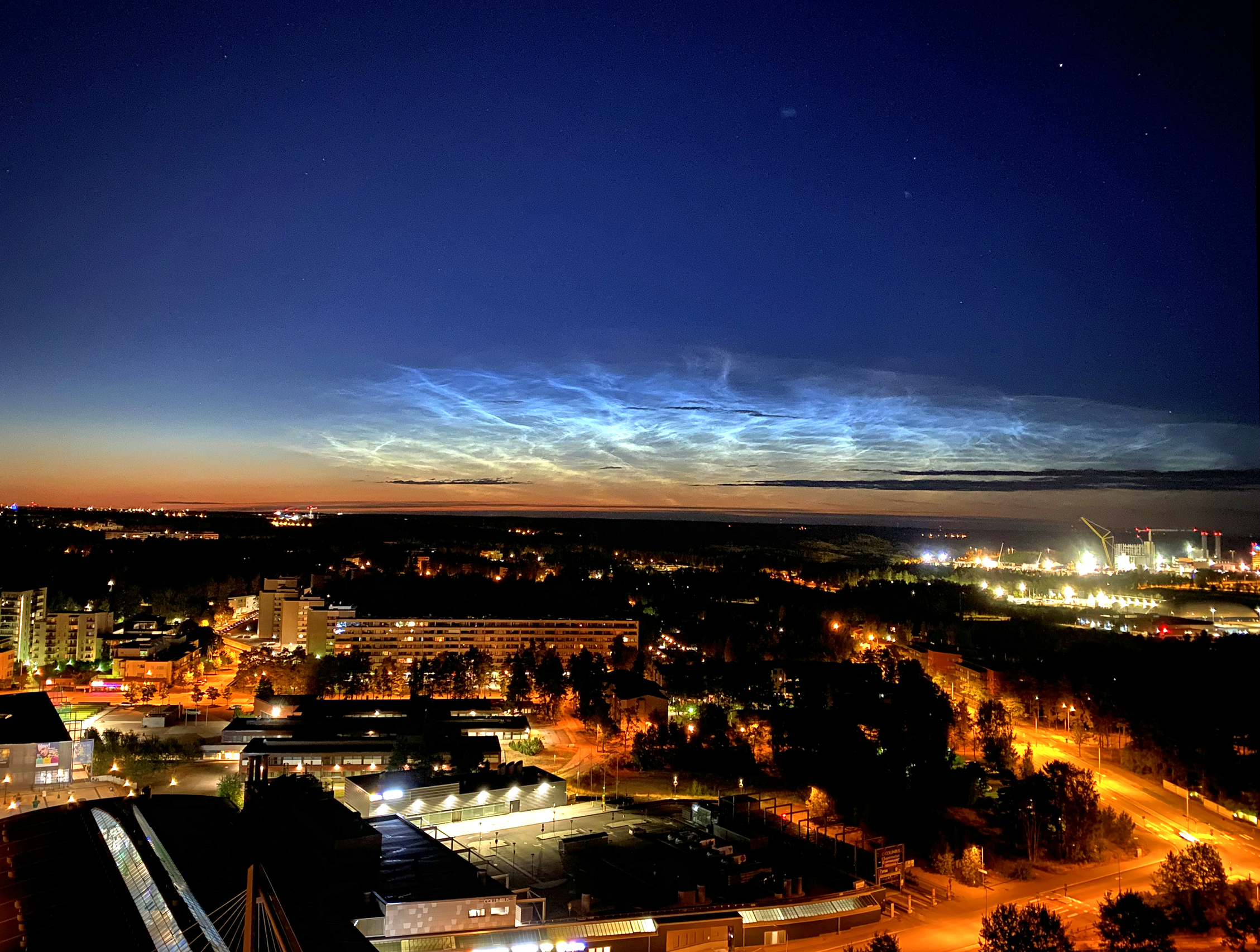
Comet Search: Under her wing
After a spring sky full of galaxies and globular clusters, you’re ready for a faint gray cotton ball of another type. A small comet is slowly gliding up eastern Aquila. The 237th comet to be recognized as periodic, this one remains beyond Mars’ orbit and never brightens to binocular range.
Use a 10-inch scope under a dark sky to visually detect 237P/LINEAR, or pick it up its 11th- to 12th-magnitude glow with a telephoto lens on a star-tracker. It should be quite round, as its feeble tail is stretched out behind the compact coma.
Discovered in 2002 by the prolific Lincoln Laboratory Near-Earth Asteroid Research (LINEAR) program, 237P is a Jupiter-family comet. Its 6.6-year orbit gives us one chance every 20 years to see it at its best.
Observers south of the equator can also easily catch 9th-magnitude C/2021 T4 (Lemmon) before dawn.
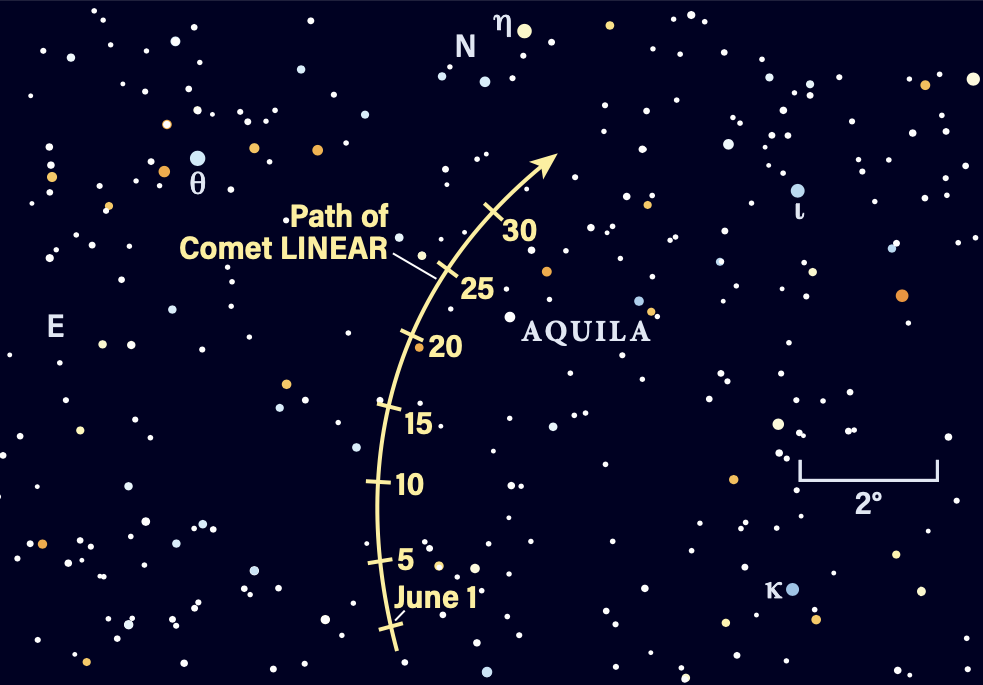
Location Asteroids: Mom comes for a visit
Our eyes draw us along the line from Venus and Mars through blue-white Regulus to sparkling Spica. Pop up a bit to 2nd-magnitude Denebola, the tail of Leo, and its fainter companion Omicron (ο) Virginis in the head of Virgo. The Virgin is sometimes said to depict the Greek maiden Persephone, whose mother was Demeter (called Ceres by the Romans).
It is here we seek the celestial maiden’s mother. The reigning queen of the main belt, 1 Ceres spans 600 miles but is fading past 8th magnitude as it falls behind speedier Earth. Any small telescope will readily pick up the dot of light from the suburbs, all the easier this month thanks to the sparse star fields and their simple patterns that won’t confuse.
To note a shift from night to night, simply place four stars inside a circle in your logbook, using an eyepiece that shows about a degree (or twice the apparent diameter of the Full Moon). Return an evening or two later and note the one that moved. The best night to see Ceres move in just a couple of hours is the 6th, when it closes in on a slightly fainter star. Avoid June 23 to 27 altogether, when the Moon is nearby.
If you’re at a dark site finding Messier galaxies, you can simply slide northwest from M49 to pick up the easier Ceres.
